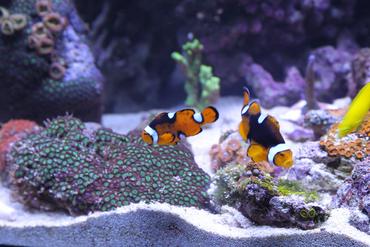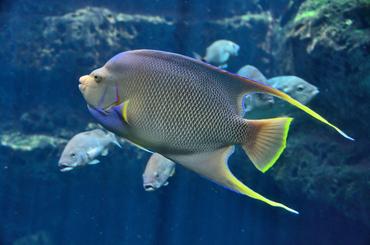CLOWNFISH IN THE REEF AQUARIUM

Updated
Clownfish are one of the most recognizable types of saltwater aquarium fish. If you are looking for a colorful species to add to your tank, consider the clownfish.
If you are looking for the perfect species to use in stocking your saltwater or reef aquarium, consider the clownfish. Clownfish are a group of saltwater fishes known for their bright orange and black coloration. These fish are not only colorful, but they are also hardy in the saltwater tank and they can be very amusing as aquarium inhabitants. Before you decide whether or not clownfish are right for you and your tank, take the time to learn the basics about these fish. Once you learn about the basic requirements of clownfish and explore the different species you will be able to make an informed decision regarding whether these are the right fish for you.
Popular Species
Clownfish belong to the subfamily Amphiprioninae in the family Pomacentridae and there are about 30 different species. While many clownfish remain small, some can grow up to 7 inches long. The most common coloration for clownfish is yellow or orange – sometimes with a reddish tint – offset by white bars or patches outlined in black. The most easily recognized species of clownfish is the Ocellaris clownfish which exhibits a bright orange body with vertical white bars and black edging on the fins and bars. This species only grows to about 3 ½ inches in length and is generally easy to care for in the saltwater tank. Ocellaris clownfish are frequently tank-bred due to their popularity in the aquarium trade which means that many of them are likely to accept commercial food diets. Tank-bred Ocellaris clownfish are also hardier and easier to breed in captivity than wild-caught specimens.
Another popular species of clownfish is the Percula clownfish. This species is very similar in appearance to the Ocellaris clownfish but they are usually a little smaller. Percula clownfish in the wild are known for their symbiotic relationship with anemones but, in captivity, they can get along without them. This species is native to the Indo-Pacific region and can also be found off the coast of Australia. These fish prefer tanks decorated with live rock and generally do well in reef tanks. It may take the Percula clownfish a little longer to adapt to the home aquarium than the Ocellaris but, once they settle in, these fish are still a hardy species. Percula clownfish are omnivorous by nature and thus require a varied diet of both vegetable and protein sources.
The Fiji Barberi clownfish is a fairly new species, having only been recently described. This species is generally found throughout the Western Pacific and it has a unique coloration. Rather than exhibiting multiple white bands, the Fiji Barberi clownfish has a reddish orange body with a single white bar behind the eye. This species typically grows to between 3 and 4 inches long and it should be considered a semi-aggressive species – these clownfish may not get along well with shy or passive species. In the home aquarium, Fiji Barberi clownfish require a varied diet of meaty live foods in addition to frozen and flake foods. For the best chances of success, keep this species in a large reef tank decorated with plenty of live rock.
Another lesser known species of clownfish is the Saddleback Clownfish. Also known as the Black Saddleback Clownfish, this species is mostly black with yellow coloration on the face and outlining the fins – this species also exhibits vertical white bars behind the eyes and pectoral fins. The Saddleback clownfish grows up to 4 inches in length and it tends to be semi-aggressive in the home aquarium. Though these fish can sometimes get along with other species, they do tend to be aggressive toward conspecifics. This species requires an omnivorous diet consisting of meaty live foods as well as herbivorous foods such as dried seaweed and flake foods. Like all clownfish, this species does exhibit a symbiotic relationship with anemones in the wild and thus can be kept in a reef tank with anemones. In large tanks, Saddleback clownfish can be kept in small groups with a host anemone species including Carpet anemones, Sebae anemones and Ritteri anemones.
Tank Set-up Tips
Most clownfish species grow between 2 and 8 cm long, so they remain fairly small. Clownfish are hardy by nature so they can adapt to a variety of tank conditions – though this may be true, these fish prefer salinity around 1.026 and they generally do best in reef tanks. Though many clownfish species remain small, it is best to keep these fish in a tank no smaller than 20 gallons in capacity. Some species of clownfish can be kept in nano reef tanks but if you plan to keep several of them in the same tank, the larger the tank is the better luck you will have.
In addition to considering the size of tank for your clownfish you should also consider how you are going to set it up. Clownfish typically prefer sand or crushed coral substrate at a depth of 1 to 2 inches. In terms of decorating the tank, clownfish are most likely to thrive in a reef tank environment. Keeping corals in a saltwater tank can be tricky, however, so be sure you are ready for the challenge if you decide to attempt this. Before adding corals to your tank, the tank should be fully cycled and established – you may need to wait several months after setting up your tank to add the corals.
In addition to corals, you might also want to think about adding some anemones to your tank. Clownfish in the wild have a symbiotic relationship with anemones – the anemones provide the clownfish with shelter and protection from predators while the clownfish removes parasites from the anemone. If you plan to keep anemones in your tank you will need to provide strong lighting and water movement – intense lighting is necessary to foster photosynthesis and strong water movement will oxygenate the tissues of the anemones, helping to wash away waste products. Before adding any anemones to your tank, be sure you have the right tank setup in place. Some anemones prefer to attach to hard substrates with others can be kept in sand. You will also need to consider how you are going to feed your anemones in order for them to thrive.
Care and Feeding
Maintaining stable salinity in the saltwater tank is incredibly important not only for clownfish but for all saltwater aquarium inhabitants. In addition to keeping the salinity stable you will also need to monitor the tank temperature, the pH and ammonia/nitrate levels. As part of maintaining your clownfish tank you will need to invest in an aquarium water test kit. Testing your aquarium water on a weekly basis should become a part of your normal maintenance routine. Be sure to record the results of your water tests in a journal so you can get an idea what chemical levels are normal for your tank – that way, if anything should change, you will be able to notice right away and make the necessary adjustments. Performing weekly water changes of 10% to 20% of the tank volume will also be important in maintaining a healthy environment for your clownfish. Be sure to keep a supply of fresh saltwater on hand so you can perform these water changes as needed.
In addition to maintaining the tank for your clownfish you also need to carefully consider what you are going to feed them. In the wild, clownfish have a relatively small territory and thus a fairly limited diet. Most species of clownfish feed on small invertebrates as well as algae and plankton. In the home aquarium, most clownfish will accept live foods and some can get used to a diet of flake foods and pellets. What foods your clownfish are likely to accept may vary depending whether they were wild-caught or not. Wild-caught specimens may take longer to adjust to a commercial food diet so you might need to feed them more live foods until they make the transition.
Compatible Tank Mates
Finding compatible tank mates for clownfish can sometimes be tricky. Though clownfish are generally not aggressive by nature, they may have trouble if kept in a tank with large species and other clownfish. In the wild, clownfish generally claim an anemone as their territory and often do not stray more than a few inches from that territory for most of their lives. In the home aquarium, clownfish may exhibit similar behavior, becoming very territorial especially around other clownfish. If you plan to keep other fish in the tank with your clownfish you first need to make sure you have enough space. Overcrowding can be very dangerous for your fish because it will increase their stress levels thus making them more susceptible to aquarium fish diseases and it may also impact the water quality in your tank. If you have enough space, you may be able to keep small, non-aggressive species with your clownfish. Before adding any more fish, make sure that your clownfish are well settled and then add the new fish one at a time to prevent problems.
Keeping any kind of saltwater reef tank can be a challenge but it can also be very rewarding. Saltwater aquarium fish are some of the most colorful and uniquely patterned fish in the animal kingdom and they are a pleasure to keep in the home aquarium. Clownfish are no exception to this rule, exhibiting bright white, orange and black colorations in bold striped patterns. These fish are a joy to keep in the saltwater tank but, like all fish, they do require certain tank specifications in order to thrive. If you plan to keep clownfish in your tank, take the time to do some simple research beforehand so you can provide your clownfish with the best tank environment possible.































































































